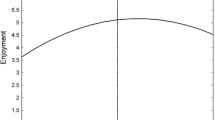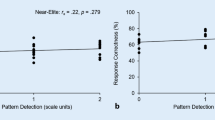Abstract
The generalized matching law was used to evaluate play selection (passing versus rushing) in professional football game situations defined by combinations of football-specific factors. Archival statistics were analyzed to determine whether play selection covaried with yards gained from passing and rushing plays, and whether the details of this relationship, as measured by the matching law's fitted parameters, varied systematically across game situations. The matching law accounted for substantial variance in play selection for several combinations of game situations, and statistically significant situation-interaction effects were found for bias, but not sensitivity. Follow up analyses revealed that, across game situations, play-selection bias effects were closely related to relative probability of a turnover (can be described in terms of punishment) and the relative yards-gained variance (which can be described in terms of variable-magnitude reinforcement schedules). These results bolster an operant-choice interpretation of football play selection; they reveal two separate aspects of play preference (generic matching versus bias); and provide a rare example of how face-valid effects in a domain of everyday interest may relate to a theoretically-important term of a laboratory-based quantitative model of choice.



Similar content being viewed by others
Notes
A common critique of field extensions of the GML concerns this very issue of parallels in contingencies. For a variety of reasons related to convenience in behavior measurement, laboratory studies of choice tend to employ concurrent variable-interval reinforcement schedules. Critiques of field extensions often focus on the fact that everyday contingencies are unlikely to be "pure" variable interval schedules. For example, reinforcers inherent in contingencies of sports like football may have ratio-like properties. It is widely thought that matching does not occur in concurrent ratio schedules. According to this line of reasoning, effects like those described in the present article, although well described by the GML, must be spurious because they result from contingencies that cannot support matching. Our response is to acknowledge that sport contingencies probably have both interval and ratio properties, and to point to numerous laboratory experiments showing that matching models do a good job of accounting for choice under hybrid ratio-interval contingencies (Green et al. 1983; LaBounty and Reynolds 1973; Savastano and Fantino 1994; Shurtleff and Silberberg 1990). The fact that no existing laboratory experiment has arranged contingencies exactly like those in most field settings leaves room for debate about the generality of laboratory results, and we would like to see more laboratory experiments devised specifically to examine the effects of contingencies as they operate in the field.
References
Alferink, L. A., Critchfield, T. S., Hitt, J. L., & Higgins, W. J. (2009). Generality of the matching law as a descriptor of basketball shot selection. Journal of Applied Behavior Analysis, 42, 595–608.
Allen, P. (2002). Passing on third down. In American Football Coaches Association (Ed.), Football Coaching Strategies (pp. 74–75). Champaign: Human Kinetics Press.
American Football Coaches Association (Ed.). (2000). Offensive football strategies. Champaign: Human Kinetics Press.
Baum, W. M. (1974). On two types of deviation from the matching law: Bias and undermatching. Journal of the Experimental Analysis of Behavior, 22, 231–242.
Baum, W. M. (1979). Matching, undermatching, and overmatching in studies of choice. Journal of the Experimental Analysis of Behavior, 32, 269–281.
Billington, E. J., & DiTommaso, N. M. (2003). Demonstrations and applications of the matching law in education. Journal of Behavioral Education, 12, 91–104.
Borrero, J. C., Crisolo, S. S., Tu, Q., Rieland, W. A., Ross, N. A., Francisco, M. T., et al. (2007). An application of the matching law to social dynamics. Journal of Applied Behavior Analysis, 40, 589–601.
Bulow, P., & Meller, P. (1998). Predicting teenage girls’ sexual activity and contraception use: An application of matching law. Journal of Community Psychology, 26, 581–596.
Conger, R., & Killeen, P. (1974). Use of concurrent operants in small group research - demonstration. Pacific Sociological Review, 17, 399–416.
Critchfield, T. S., Paletz, E. M., MacAleese, K. R., & Newland, M. C. (2003). Punishment in human choice: Direct or competitive suppression? Journal of the Experimental Analysis of Behavior, 80, 1–27.
Critchfield, T. S., & Reed, D. D. (2009). What are we doing when we translate from quantitative models? The Behavior Analyst, 32, 339–362.
Davison, M., & Hogsden, I. (1984). Concurrent variable-interval schedule performance: Fixed versus mixed reinforcer durations. Journal of the Experimental Analysis of Behavior, 41, 169–182.
Davison, M., & McCarthy, D. (1988). The matching law: A research review. Hillsdale: Erlbaum.
Davison, M., & Nevin, J. A. (1999). Stimuli, reinforcers, and behavior: An integration. Journal of the Experimental Analysis of Behavior, 71, 439–482.
Edwards, L. (1995). The passing game. In American Football Coaches Association (Ed.), The football coaching bible (pp. 227–239). Champaign: Human Kinetics Press.
Farley, J., & Fantino, E. (1978). The symmetrical law of effect and the matching relation in choice behavior. Journal of the Experimental Analysis of Behavior, 29, 37–60.
Fulmer, P. (2002). Fast break, two-minute offense. In American Football Coaches Association (Ed.), Football Coaching Strategies (pp. 80–82). Champaign: Human Kinetics Press.
Green, L., Rachlin, H., & Hanson, J. (1983). Matching and maximizing with concurrent ratio-interval schedules. Journal of the Experimental Analysis of Behavior, 40, 217–224.
Kollins, S. H., Newland, M. C., & Critchfield, T. S. (1997). Human sensitivity to reinforcement in operant choice: How much do consequences matter? Psychonomic Bulletin & Review. 4, 208-220. Erratum: Psychonomic Bulletin & Review, 4, 431.
LaBounty, C. E., & Reynolds, G. S. (1973). An analysis of response and time matching to reinforcement in concurrent ratio-interval schedules. Journal of the Experimental Analysis of Behavior, 19, 155–166.
Levy, M. (1999). Beating the clock. In American Football Coaches Association (Ed.), Offensive Football Strategies (pp. 281–286). Champaign: Human Kinetics Press.
Lunneborg, C. E. (1994). Modeling experimental and observational data. Belmont: Duxbury Press.
Magoon, M. A., & Critchfield, T. S. (2008). Concurrent schedules of positive and negative reinforcement: Differential-impact and differential-outcomes hypotheses. Journal of the Experimental Analysis of Behavior, 90, 1–22.
McAdie, T. M., Foster, T. M., & Temple, W. (1996). Concurrent schedules: Quantifying the aversiveness of noise. Journal of the Experimental Analysis of Behavior, 65, 37–55.
McCorduck, E. (1998). Understanding American football. Chicago: NTC Publishing.
McDowell, J. J., & Caron, M. L. (2010). Bias and undermatching in delinquent boys' verbal behavior as a function of their level of deviance. Journal of the Experimental Analysis of Behavior, 93, 471–483.
Motulsky, H., & Christopoulis, A. (2006). Fitting models to biological data using linear and nonlinear regression: A practical guide to curve fitting. San Diego: GraphPad Software.
Rasmussen, E. B., & Newland, M. C. (2008). Asymmetry of reinforcement and punishment in human choice. Journal of the Experimental Analysis of Behavior, 89, 157–167.
Reed, D. D., Critchfield, T. S., & Martens, B. K. (2006). The generalized matching law in elite sport competition: Football play calling as operant choice. Journal of Applied Behavior Analysis, 39, 281–297.
Reed, D. D., Scoch, J. J., Kaplan, B. A., & Brozyna, G. A. (2011). Defensive performance as a modulator of biased play calling in collegiate American-rules football. Mexican Journal of Behavior Analysis, 37, 51–57.
Rockerbie, D. W. (2008). The passing premium puzzle revisited. Journal of Quantitative Analysis in Sport, 4, 1–11.
Romanowich, P., Bourret, J., & Vollmer, T. R. (2007). Further analysis of the matching law to describe two- and three-point shot allocation by professional basketball players. Journal of Applied Behavior Analysis, 40, 311–315.
Savastano, H., & Fantino, E. (1994). Human choice in concurrent ratio-interval schedules of reinforcement. Journal of the Experimental Analysis of Behavior, 61, 453–463.
Shurtleff, D., & Silberberg, A. (1990). Income maximizing on concurrent ratio-interval schedules of reinforcement. Journal of the Experimental Analysis of Behavior, 53, 273–284.
Stilling, S. T. (2009). Offensive play-calling in professional football: An operant-choice analysis. Unpublished Master's Thesis, Illinois State University.
Stilling, S. T., & Critchfield, T. S. (2010). The matching relation and situation-specific bias modulation in professional football play selection. Journal of the Experimental Analysis of Behavior, 93, 435–452.
Vollmer, T. R., & Bourret, J. (2000). An application of the matching law to evaluate the allocation of two-and three-point shots by college basketball players. Journal of Applied Behavior Analysis, 33, 137–150.
Westering, F. (2002). Offensive play calling in key game situations. In American Football Coaches Association (Ed.), The football coaching bible (pp. 315–326). Champaign: Human Kinetics Press.
Zar, J. H. (1999). Biostatistical analysis (4th ed.). Upper Saddle River: Prentice Hall.
Author Note
For assistance with data collection we thank Brittney Augello and Kelsey Zulz. Address correspondence to T. Critchfield, Psychology Department, Campus Box 4620, Illinois State University, Normal, IL 61790. Electronic mail: tscritc@ilstu.edu.
Author information
Authors and Affiliations
Corresponding author
Appendix
Appendix
Rights and permissions
About this article
Cite this article
Critchfield, T.S., Meeks, E. & Stilling, S.T. Explanatory Flexibility of the Matching Law: Situational Bias Interactions in Football Play Selection. Psychol Rec 64, 371–380 (2014). https://doi.org/10.1007/s40732-014-0064-5
Published:
Issue Date:
DOI: https://doi.org/10.1007/s40732-014-0064-5




